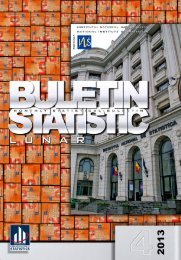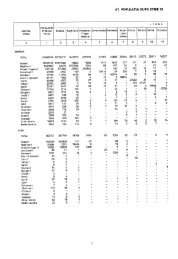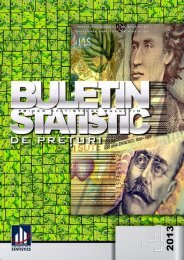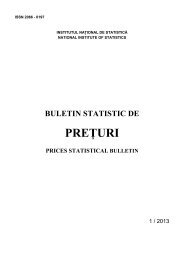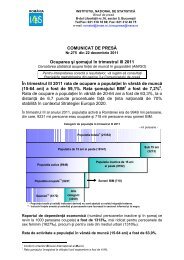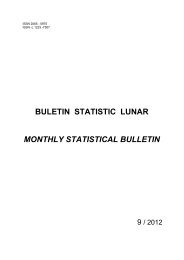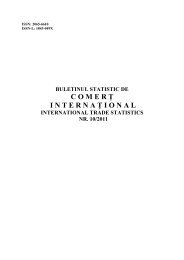buletin statistic de industrie industry statistical bulletin nr. 5/2012
buletin statistic de industrie industry statistical bulletin nr. 5/2012
buletin statistic de industrie industry statistical bulletin nr. 5/2012
Create successful ePaper yourself
Turn your PDF publications into a flip-book with our unique Google optimized e-Paper software.
alta şi efectului calendarului (Paştele<br />
ortodox, an bisect şi alte sărbători<br />
naţionale) precum şi i<strong>de</strong>ntificarea şi<br />
corectarea valorilor extreme (schimbări<br />
<strong>de</strong> nivel ocazionale, tranzitorii sau<br />
permanente) şi interpolarea valorilor<br />
lipsă.<br />
Seria ajustată cu numărul <strong>de</strong> zile<br />
lucrătoare s-a obţinut prin eliminarea din<br />
seria brută a acestor efecte, cu ajutorul<br />
unor coeficienţi <strong>de</strong> corecţie, stabiliţi în<br />
funcţie <strong>de</strong> mo<strong>de</strong>lul <strong>de</strong> regresie folosit<br />
(aditiv sau multiplicativ).<br />
Stabilirea mo<strong>de</strong>lelor <strong>de</strong> regresie<br />
folosite pentru fiecare serie se face la<br />
începutul fiecărui an şi implică<br />
recalcularea seriilor ajustate calculate în<br />
anul prece<strong>de</strong>nt (recalculare datorată<br />
modificării mo<strong>de</strong>lelor adoptate, numărului<br />
<strong>de</strong> regresori folosit şi numărului <strong>de</strong><br />
observaţii disponibile).<br />
Ajustarea nivelurilor agregate<br />
(secţiune, total <strong>industrie</strong>, mari grupe<br />
industriale) s-a realizat prin metoda<br />
directă care presupune ajustarea directă<br />
a seriilor agregate. Utilizarea meto<strong>de</strong>i<br />
directe poate conduce la unele<br />
inconsistenţe în seriile <strong>de</strong> date (respectiv,<br />
agregatele să nu fie cuprinse întot<strong>de</strong>una<br />
între valorile componentelor din care<br />
provin).<br />
Indicii producţiei industriale sunt<br />
provizorii şi se revizuiesc pe baza<br />
rectificărilor ce se efectuează retroactiv<br />
<strong>de</strong> către întreprin<strong>de</strong>rile din eşantion,<br />
asupra datelor furnizate anterior <strong>de</strong> către<br />
acestea.<br />
Indicele productivităţii muncii în<br />
<strong>industrie</strong><br />
Indicele productivităţii muncii în<br />
<strong>industrie</strong> este indicatorul ce<br />
caracterizează eficienţa muncii <strong>de</strong>puse<br />
într-o anumită perioadă în cadrul activităţii<br />
industriale şi se calculează ca raport între<br />
indicele brut al producţiei industriale şi<br />
indicele numărului mediu <strong>de</strong> salariaţi din<br />
<strong>industrie</strong>.<br />
Indicii productivităţii muncii în<br />
<strong>industrie</strong> sunt calculaţi pe total <strong>industrie</strong>,<br />
secţiuni (industria extractivă,<br />
prelucrătoare şi producţia şi furnizarea <strong>de</strong><br />
energie electrică şi termică, gaze, apă<br />
caldă şi aer condiţionat), diviziuni CAEN<br />
Rev.2 precum şi mari grupe industriale.<br />
Indicii lunari ai productivităţii<br />
muncii în <strong>industrie</strong> sunt provizorii şi se<br />
revizuiesc pe baza rectificărilor ce se<br />
another and calendar effect (Orthodox<br />
Easter, bissextile year and other national<br />
holidays) as well as i<strong>de</strong>ntification and<br />
correction of extreme values (occasional,<br />
transition or permanent changes) and<br />
interpolation of missing values.<br />
Adjusted series with working days<br />
number was obtained eliminating from<br />
unadjusted series those effects by means<br />
of correction coefficients, set up<br />
according to regression mo<strong>de</strong>l used<br />
(additive or multiplicative).<br />
Regression mo<strong>de</strong>ls used for each<br />
series are set up at the begining of each<br />
year, involving the recalculation of<br />
adjusted series calculated in the previous<br />
year (recalculation due to thr change of<br />
the adopted mo<strong>de</strong>ls, number of<br />
regressors used and number of available<br />
observations).<br />
Aggregated levels (section, total<br />
<strong>industry</strong>, broad industrial groups) were<br />
adjusted by means of direct method<br />
supposing direct adjustment of<br />
aggregated series. Using the direct<br />
method could lead to some<br />
inconsistencies in data series<br />
(respectively, aggregated should not be<br />
always inclu<strong>de</strong>d among the values of their<br />
origin components).<br />
The industrial production indices<br />
are provisional and are revised based on<br />
the corrections retroactively done by the<br />
enterprises in the sample, concerning the<br />
data previously provi<strong>de</strong>d.<br />
Labour productivity in<strong>de</strong>x in<br />
<strong>industry</strong><br />
Labour productivity in<strong>de</strong>x in<br />
<strong>industry</strong> is the indicator which<br />
characterizes the efficiency of work<br />
during a certain period of time of<br />
industrial activity and is calculated as<br />
ratio between the gross industrial<br />
production in<strong>de</strong>x and the in<strong>de</strong>x of<br />
average number of employees in<br />
<strong>industry</strong>.<br />
Labour productivity indices in<br />
<strong>industry</strong> are calculated per total <strong>industry</strong>,<br />
sections (mining and quarrying,<br />
manufacturing and electricity, gas,steam<br />
and air conditioning supply) and CANE<br />
Rev.2 divisions, as well as broad<br />
industrial groups.<br />
Monthly labour productivity indices<br />
in <strong>industry</strong> are provisional and they are<br />
revised on the basis of retroactive<br />
103



